Voltage and current can be quantified using meters.

A pine board with a battery holder made of nails and alligator
clips is used to hold Christmas tree lights.
Voltage and current can be quantified using meters.

A pine board with a battery holder made of nails and alligator
clips is used to hold Christmas tree lights.
Material
Assembly
Cut the lights apart leaving 10 cm (3") of wire
connected to each bulb.
Cut the plastic insulation off the last 1 cm of wire, 0.5 inch.
Build a breadboard by screwing alligator clips onto a wooden plank
see above.
Add a battery holder by driving nails into the plank.
To Do and Notice
Notice that the voltmeter and ammeter should both have a red lead attached to their positive terminals and a black lead attached to their COM or common terminals.
Symbols
We'll use the symbol ![]() for a battery, where the large plate indicates the positive
end,
for a battery, where the large plate indicates the positive
end,
and the symbol ![]() for a bulb or resistor.
for a bulb or resistor.
Connect the bulb to one battery.

Attach the voltmeter across the bulb.
Break the circuit and insert the ammeter between the battery and the bulb.
Notice that the voltmeter reads the voltage,
probably near 1.5 volts.
The voltage is positive if the red lead of the voltmeter is at the
higher voltage. If the red lead is attached near the positive end of
the battery it will read a positive voltage. If the leads are
reversed the voltage will read negative.
Notice that if positive current flows into the red lead of the ammeter that the current will be positive. Reverse the leads and the current is negative.
Here is a meter measuring the voltage across one bulb.
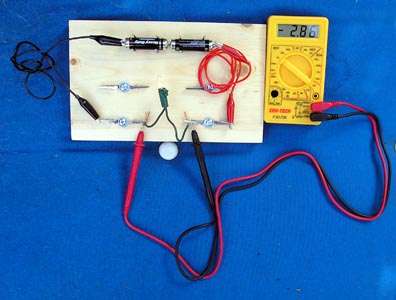
Here is a meter measuring the current through one bulb.
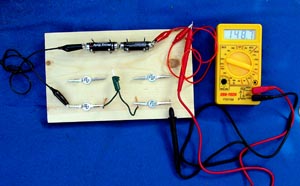
Build the two bulb series and parallel circuits. Measure the currents through and voltages across the bulbs in these circuits.
What's Going On?
In the series circuit with two bulbs
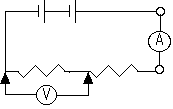
The current through the circuit is the same everywhere.
The voltage splits between the two bulbs.
If the bulbs are identical the voltage splits equally between them,
measure them both.
In the circuit with two bulbs in parallel:
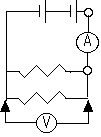
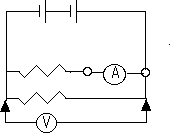
The current is split between the two bulbs.
If the bulbs are identical half the current goes through each
one.
Math Root
Adding two resistors in series.
Two resistors in series act as if they were one resistor with the sum of the resistances.
R = R1 + R2
So two bulbs in series have twice the resistance of one bulb.
Doubling the resistance cuts the current in half according to ohms law.
I = V/R
Adding two resistors in parallel.
Two equal resistors in parallel behave like one resistor with half the resistance.
Or more generally
1/R = 1/R1 + 1/R2
That's a lot of one-overs!
|
Scientific Explorations with Paul Doherty |
|
7 October 2000 |